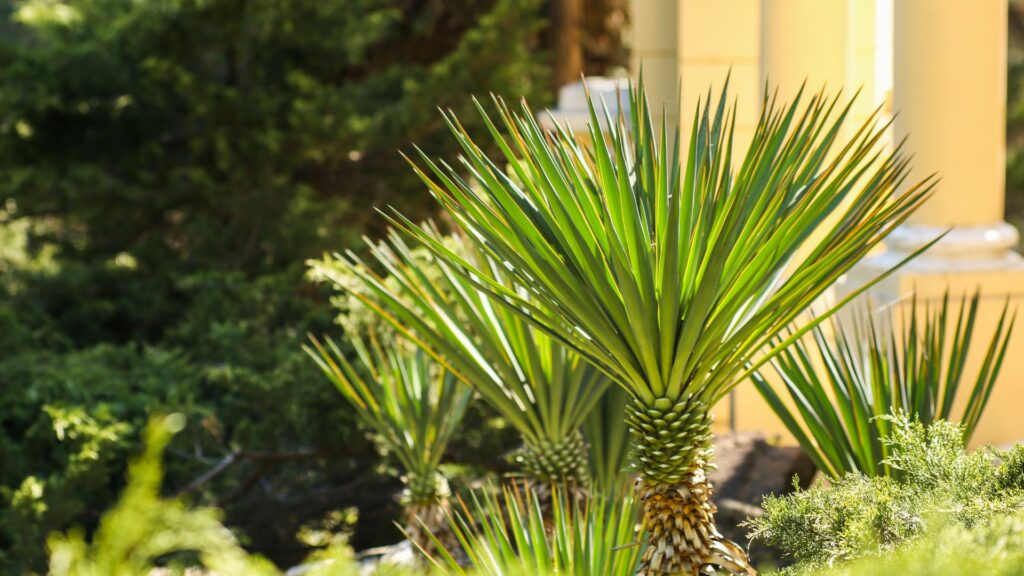Palm trees are iconic symbols of the Florida landscape, conjuring up visions of a tropical paradise with sun-soaked beaches. These majestic trees can thrive in the Sunshine State’s unique climate, but for them to flourish, they need some TLC, including regular fertilization.
Fertilizing your Florida palm tree is essential for ensuring its health, but precisely when and how is best to achieve lush growth?
For lush growth, gardeners should fertilize Florida palm trees four times a year. Using a controlled-release fertilizer with the proper balance of nutrients is essential for preventing common deficiencies and diseases. Use 1.5 lbs of fertilizer for every 100 square feet needing treatment.
Florida has at least fifty types of palm, with twelve indigenous to the state. It comes as no surprise, then, that the state tree is also a palm tree, namely the sabal palm. Many Sunshine State homeowners choose palms to create a tropical feel to their gardens and because they flourish in this area. Maintaining their beauty and lush growth depends on the fertilization secrets divulged here.
When and How to Fertilize Florida’s Palm Trees

Before addressing the “how” and “when” regarding Florida’s palm tree fertilization, you may ask why it’s necessary. Once established, most shade trees don’t need much fertilization. However, palm trees are more closely related to bamboo and grasses and require more intense care.
Although Florida soil composition varies greatly, palm trees often struggle with deficiencies of nutrients such as potassium, nitrogen, manganese, magnesium, iron, and boron. Fertilizer helps to prevent these deficiencies, which can sometimes result in the plant’s death. Potassium or magnesium deficiency is often the root cause of many Florida palm trees’ demise.
Fertilize Your Palm Trees Regularly
Most gardeners in the know fertilize their Florida palms quarterly. You can start in mid-February to March for spring, mid-May to June for summer, and September for fall, and then feed them a small amount during early winter before the coldest weather sets in.
Despite their stunning evergreen foliage, palms go dormant during the winter, resulting in them not absorbing any nutrients during that time. Depending on the temperatures, they may remain in that state for about two months, so having some reserves to draw on before the first possible freeze can be beneficial.
Use the Correct Fertilizer for Palm Trees
Palm trees have different nutrient requirements than other plants, so feeding them palm-specific fertilizer is essential. The goal of correctly fertilizing these trees is to prevent deficiency symptoms. Once the plant is affected, the foliage will continue to display the damage until it dies or is pruned. The improvement from fertilization will only show in the new leaves.
Florida’s palm trees need an optimal combination of phosphorous, potassium, nitrogen, and a few micronutrients. The Sunshine State’s palms often grow in sandy, calciferous soil. In areas with abundant rain, nutrients easily leach from the ground, leaving the plants vulnerable to deficiencies and poor health.
Using the wrong type of fertilizer on your palm trees can be worse than not using any at all, as it can hasten the death of an ailing tree. Palm tree fertilizers should have a 2N: 3K: 1Mg nutrient ratio. The correct type will have either of the following analyses on the bag: 8-2-12+5mg or 8-0-12+4mg. These numbers show the percentages of nitrogen, phosphorus, potassium, and magnesium, respectively.
Simply having the correct numbers written on the fertilizer bag doesn’t mean it is suitable for your palms. Some elements are insoluble, others are completely soluble, and those most suitable for Florida’s palm trees are controlled-release.
Research indicates that these four nutrients must come in a controlled-release form for efficient fertilization. If this is not the case, the rain could wash the nutrients into the soil, rendering them unavailable to feed the palm tree and causing it to become deficient in essential elements.
Follow these Fertilizing Tips for Lush Growth
The following steps will help you learn how to fertilize palm trees for lush growth and vitality:
- When planting a new palm tree, you can coat the base of the tree in fertilizer, adding some extra to the sides when you add your backfill.
- Apply a mulch layer around the palm tree’s base to retain moisture and minimize weeds.
- Calculate the area around the palm tree needing fertilization. The roots can extend 30 – 40 feet away from the trunk, depending on the size.
- For every 100 square feet, use 1.5 pounds of fertilizer. Scatter it evenly around the trunk and as far as the drip line, the area under the outermost branches. Avoid clumps or piles.
- Do not place the fertilizer directly against the palm’s trunk, as it may burn the plant.
- Water the area to help the nutrients dissolve.
- Monitor your palm tree’s growth. Soil type, climate, and tree age can influence fertilizer efficiency. Monitor its growth and appearance and adjust your fertilization schedule accordingly.
- Whenever you fertilize your palms, remove the mulch before fertilizing, replacing it when you’re done.
Symptoms of Nutrient Deficiencies in Palm Trees
Identifying the symptoms of specific nutrient deficiencies can help you correct the problem as soon as possible. Look for these clues:
- Nitrogen deficiencies are rare in Florida soil but often occur in palms transplanted from pots. The oldest leaves turn light green, and leaf bases and petioles turn gold. The growth rate slows down, and the canopy becomes chlorotic.
- Potassium deficiencies are the most common in palm trees. The older leaves can show mottled yellow spots. Some varieties display the symptoms on the oldest leaves as marginal or tip necrosis, looking withered.
- Magnesium deficiency symptoms often reflect as chlorotic, discolored bands on the edges of the leaves, while the central parts remain green.
- Palm trees lacking manganese often show longitudinal necrotic bands on the newest leaves. As the deficiency progresses, the leaves look more and more withered.
- Boron deficiency symptoms include translucent streaks on new leaves and bent tips of the leaves.
Final Thoughts
To keep your iconic Florida palm trees in tip-top shape, it’s necessary to fertilize them roughly every three months using a palm-specific, controlled-release fertilizer.
Florida’s palm trees require the correct nutrient and micronutrient balance to flourish and maintain their lush growth and gorgeous green foliage. With a little TLC and the right fertilizer, your garden can look like a tropical paradise.

